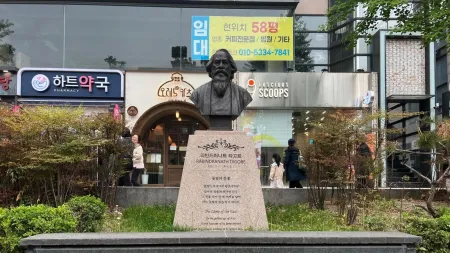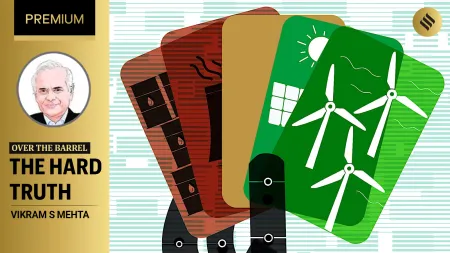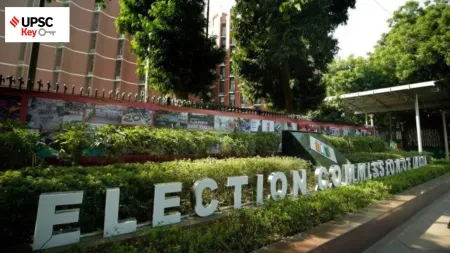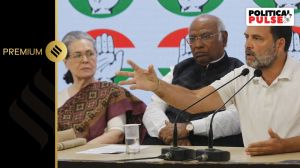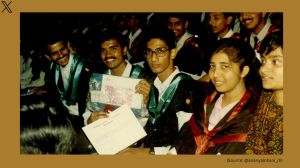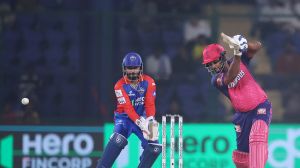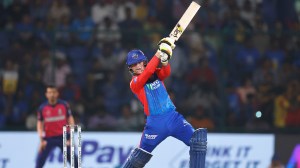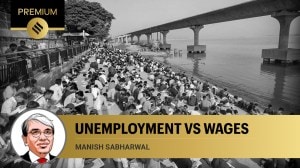- India
- International
A to Z of Ayodhya verdict
Ayodhya verdict: The 1,045-page order — its context and contents — broken down.
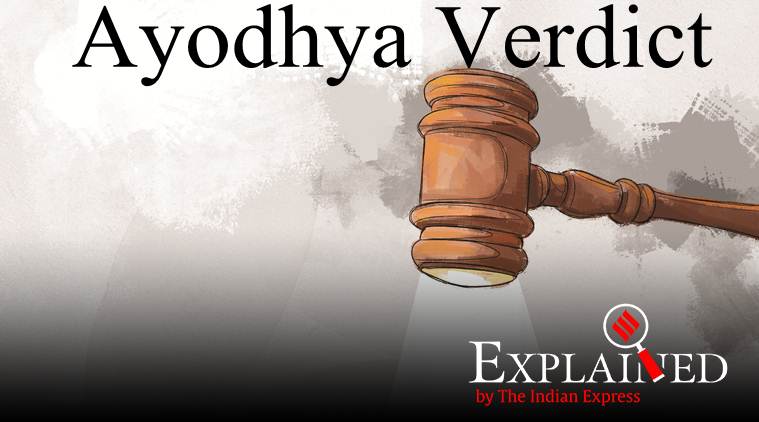 Ayodhya verdict: The unanimous judgment by a five-judge Constitution Bench brought down the curtains on a dispute that began in 1885.
Ayodhya verdict: The unanimous judgment by a five-judge Constitution Bench brought down the curtains on a dispute that began in 1885.
Ayodhya: In Faizabad district, Awadh, famous for its sunsets by the banks of the River Saryu. Its rich history and symbolism finds space in the writings of Tulsidas and Amir Khusrau. Buddha is said to have preached here. Jainism and Sikhism too have their imprint here. The Hindu-Muslim binary of the last century has, however, left little space for this history — and the identity of Ayodhya has been limited to its being the ground zero of the Ramjanmabhoomi-Babri Masjid dispute.
Read | SC verdict on Ayodhya dispute: Temple at disputed site, alternative land for mosque
Babri Masjid: The three-domed mosque that Mir Baqi built in the name of Emperor Babur, in 1528 in the Jaunpuri style, has been at the centre of the dispute. Many on the Mandir side believe that the birthplace of Lord Ram was exactly at the spot on which the Babri Masjid stood until December 6, 1992. The Supreme Court concluded that the masjid was built over a structure which was “non-Islamic”.
Constitution: The court began its order by underlining the role of the Constitution. “Constitutional values form the cornerstone of this nation and have facilitated the lawful resolution of the present title dispute through forty-one days of hearings before this Court,” says paragraph 2 of the order.
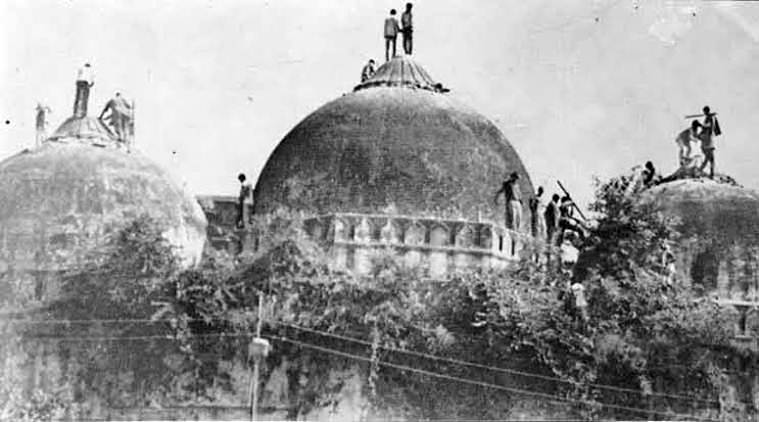 The destruction of the mosque took place in breach of the order of status quo and an assurance given to this Court.
The destruction of the mosque took place in breach of the order of status quo and an assurance given to this Court.
Demolition: At the time the Babri Masjid was demolished, UP had a BJP government, and P V Narasimha Rao of the Congress headed the government at the Centre. On Pages 913-14, the judgment says: “The destruction of the mosque took place in breach of the order of status quo and an assurance given to this Court. The destruction of the mosque and the obliteration of the Islamic structure was an egregious violation of the rule of law.”

Equity: “Equity” appears 101 times in the order, including in the title of the section, ‘Applicable legal regime and Justice, Equity and Good Conscience’. The judgment quotes widely from legal scholars on Equity, and reads it into Article 142 of the Constitution: “The phrase ‘is necessary for doing complete justice’ is of a wide amplitude and encompasses a power of equity which is employed when the strict application of the law is inadequate to produce a just outcome… It is in seeking this ultimate balance for a just society that we must apply justice, equity and good conscience…”
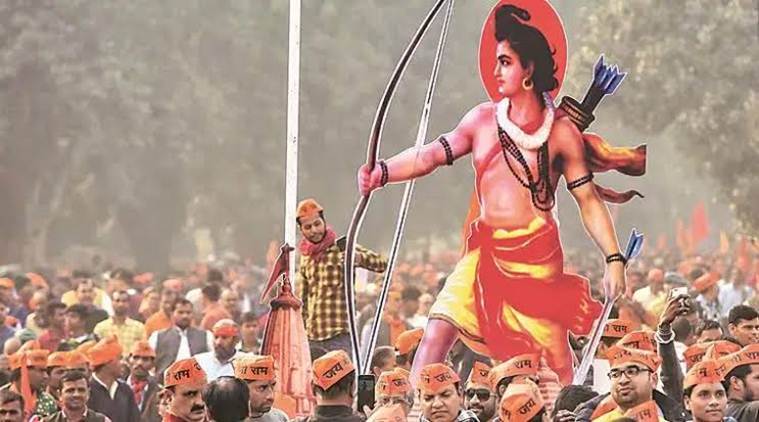 Much of the order is about historical facts and interpretation.
Much of the order is about historical facts and interpretation.
Faith: The judgment asserts the centrality of evidence to decisions, not faith and belief. However, a 116-page “Addenda” establishes the evidence of faith, ending with: “It is thus concluded on the conclusion that faith and belief of Hindus since prior to construction of Mosque and subsequent thereto has always been that Janamasthan of Lord Ram is the place where Babri Mosque has been constructed which faith and belief is proved by documentary and oral evidence discussed above.”
Read | Why Hindus won claim over both the outer and inner courtyard at disputed site
Governments: Central to the way in which a local land dispute grew into a critical moment in the history of contemporary India, is the role played by successive governments over a century and a half — from the British who erected a wall between the inner and outer portions of the Babri premises, to those of Rajiv Gandhi’s which ordered the locks opened and Narasimha Rao’s which acquired 67.7 acres in 1993. Each of these actions had powerful consequences, some of which have been recorded in the judgment.
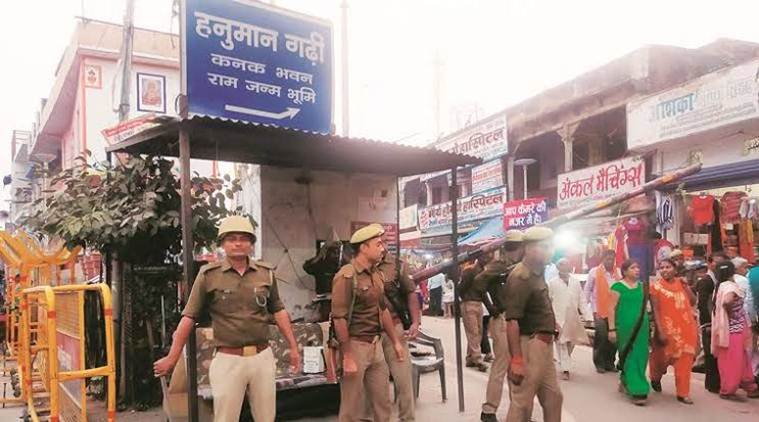 Security personnel in Ayodhya. (Express photo by Asad Rehman)
Security personnel in Ayodhya. (Express photo by Asad Rehman)
History: The story of the Babri Masjid spans nearly 500 years, beginning with Babur and ending in the country’s highest court. India’s longest-running major title dispute has turned out to be both historic and historical — releasing medieval passions among large sections of the population, making and unmaking governments, and putting to test founding principles of the modern Indian republic. Much of the order is about historical facts and interpretation.
Read | Faith establishes birth place: A post script, unsigned
Idea of India: This evocative phrase which reflects the resplendence of Indian identity (also the title of political theorist Sunil Khilnani’s signature work), appears in paragraphs 1 and 2 of the judgment. The court said the dispute was “as old as the idea of India itself”, and observed: “The lands of our country have witnessed invasions and dissensions. Yet they have assimilated into the idea of India everyone who sought their providence, whether they came as merchants, travellers or as conquerors.”

Janmasthan: The court rejected the argument put forward by plaintiffs Bhagwan Sri Ram Virajman and Asthan Sri Ram Janmabhoomi that Janmasthan was a juristic person on the grounds that this would extinguish all competing proprietary claims to the land, and render the concept of title meaningless. The ASI reported the existence of a “very fine” Ram temple at Janmasthan, and the court noted that according to the ASI, “Babar’s Masjid…was built on the very spot where the old temple Janmasthan… was standing”.
 Over 150,000 kar sevaks from across the country gathered at Ayodhya, and demolished the Babri Masjid on December 6, 1992.
Over 150,000 kar sevaks from across the country gathered at Ayodhya, and demolished the Babri Masjid on December 6, 1992.
Kar Sevaks: Thousands of religious volunteers — kar sevaks — rallied behind L K Advani during his Rath Yatra in September-October 1990. Several kar sevaks were killed in police firing. Over 150,000 kar sevaks from across the country gathered at Ayodhya, and demolished the Babri Masjid on December 6, 1992. Ten years later, on February 27, 2002, when many kar sevaks were returning from Ayodhya, the Sabarmati Express was torched near Godhra, killing 59. This sparked riots in Narendra Modi’s Gujarat, in which more than 1,000 were killed, most of them Muslims.
Temple in Ayodhya: Short history of an old Sangh Parivar demand
Land: At the heart of the title dispute were 2.77 acres of land. The judgment begins with the mention of “a dispute between two religious communities both of whom claim ownership over a piece of land admeasuring 1,500 square yards in the town of Ayodhya”. The disputed land has been granted to the Hindus for the construction of the temple. The Sunni Central Waqf Board has been given 5 acres.
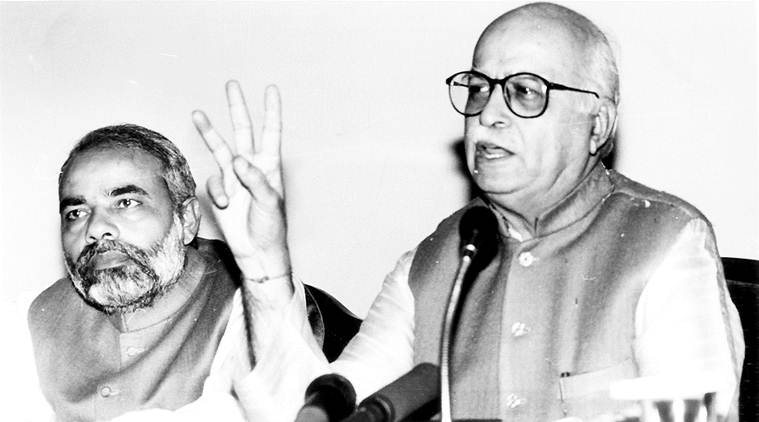 Modi coordinated a part of Advani’s rath yatra. (Archive)
Modi coordinated a part of Advani’s rath yatra. (Archive)
Modi: Now Prime Minister, Narendra Modi was one of the organisers of the Rath Yatra that Advani embarked upon on September 30, 1990 from Somnath in Gujarat. The yatra was brought to an abrupt end on October 30 after then Bihar Chief Minister Lalu Prasad Yadav ordered Advani’s arrest in Samastipur. In later years, the Ram Mandir continued to fuel the BJP’s popularity, and Modi rode a wave in 2014 to catapult his party to pole position in Indian politics.
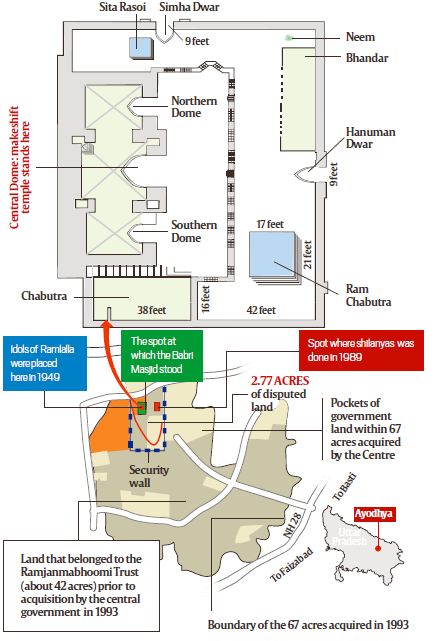
Nirmohi Akhara: One of the biggest and most powerful akharas of the Ramanandi sect has historically been associated with the spot, and argued the case vigorously at all levels for decades. It had been allotted one-third of the 2.77 acres by the Allahabad High Court in 2010, but the Supreme Court rejected its claim to shebait rights, and ordered that the akhara’s suit “is held to be barred by limitation and shall accordingly stand dismissed”.
Read | Ayodhya verdict Explained: What is adverse possession, the Muslim claim SC rejected?
Outer Courtyard: The wall erected by the British after Hindu-Muslim riots in 1856-57 divided the disputed premises into two parts: inner portion to be used by Muslims, and the outer courtyard to be used by Hindus. The Supreme Court relied on evidence pointing to exclusive ownership of the outer courtyard by Hindus, but observed that the possession of the inner portion (where the domes stood) by Muslims was always contested by Hindus. It also noted that the wall and the railing (around the disputed structure of the mosque) came about only to prevent a conflagration, and did not suggest any division of the site. The court considered the inner portion and the outer courtyard as a composite whole, paving the way for a judgment in favour of a temple.
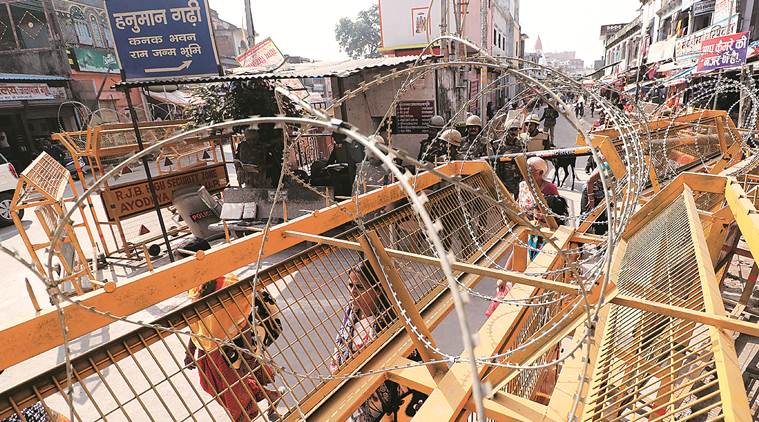 Tight security near the disputed site in Ayodhya on Saturday. (Express photo by Vishal Srivastav)
Tight security near the disputed site in Ayodhya on Saturday. (Express photo by Vishal Srivastav)
Politics: The Congress has been effusive in its praise of the judgment, a position that makes it difficult to distinguish it from the BJP. With the regional parties largely muted, the Left has been an outlier. If the demolition of the mosque in 1992 ushered in Hindutva 1.0, the reactions to the verdict appears to mark an era of broad acquiescence across most parties.
Read | From backroom boy to Prime Minister, Modi’s mandir journey
Question: The Supreme Court pronounced judgment on appeals against the 2010 Allahabad High Court judgment that ordered a three-way division of the disputed land. The HC had considered questions on broadly eight issues, including who had the possession and title, whether the outer courtyard included Ram Chabutra and Sita Rasoi, and whether the mosque had been built on the site of an ancient Hindu temple. The Supreme Court heard arguments on broadly the same questions. (Explained, November 6, 7)
Ram Lalla: One of the five suits before the Court was in the name of the deity itself, Sri Ram Lalla Virajman, and the birthplace, Asthan Shri Ram Janmabhoomi. This suit was founded on the claim that the law recognises both the idol and the birthplace as juridical entities. The court did not accept the Janmasthan as a juridical entity. It awarded the title of the land to Ram Lalla, to be held by the Trust that the Court has sought to be set up within three months.
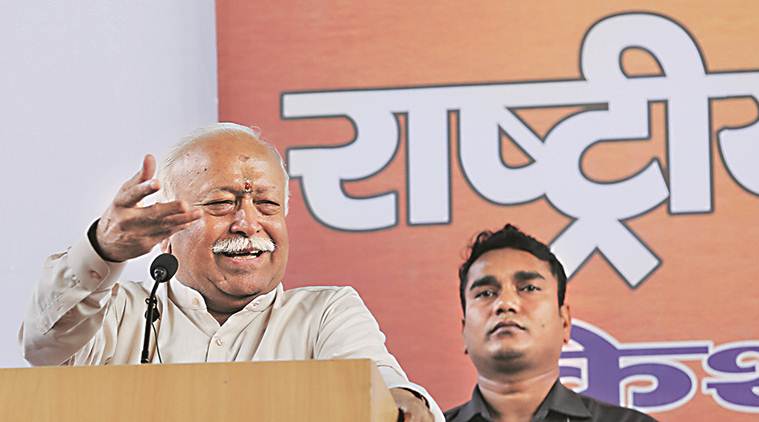 RSS chief Mohan Bhagwat addresses the media after the verdict. (Express photo by Anil Sharma)
RSS chief Mohan Bhagwat addresses the media after the verdict. (Express photo by Anil Sharma)
Sangh: The Sangh Parivar, including the RSS, VHP, and BJP, led the Ramjanmabhoomi movement, and demanded the construction of the Ram temple in Ayodhya. The Sangh Parivar has long insisted that the temple is a matter of faith and not one for courts, a view that the SC, while giving the land to Hindus, rejected. The Ramjanmabhoomi movement propelled the BJP to power, and the RSS chief welcomed the order soon after it was passed.
Trust: The court has directed the Centre to formulate within three months a scheme to set up a “Trust with a Board of Trustees or any other appropriate body” under The Acquisition of Certain Area at Ayodhya Act, 1993, with powers “including the construction of a temple”. The court has used its powers under Article 142 to direct that “appropriate representation may be given in the Trust… to the Nirmohi Akhara”.
 The unanimous judgment by a five-judge Constitution Bench brought down the curtains on a dispute that began in 1885.
The unanimous judgment by a five-judge Constitution Bench brought down the curtains on a dispute that began in 1885.
Unanimous: The Ayodhya verdict is most noteworthy for the unanimity of views of the five judges including the Chief Justice of India. Given the nature of the decades-long dispute, its political significance and religious overtones, the unanimous judgment serves to keep the temperature down. Unanimity, however, need not mean it is fair and equitable.
Violence: After the 1960s, there was a hiatus of sorts in communal rioting until the late 1980s, when Advani’s Yatra resulted in much blood being spilled. The demolition of the mosque resulted in riots that in which more than 2,000 died across cities. Mumbai saw riots lasting for more than a month.
Read | 24 mentions of ‘secular’ in Ayodhya verdict that underlines tolerance
Wall: A 6-7-foot grill-brick wall built by the British after the riots of 1856-57 marked a turning point over the use of the space by the two communities. It was intended to create a buffer between them and resolve the conflict. However, Hindus and Muslims ended up making multiple attempts to exclude each other from the site. Over time, it resulted in at least five suits, which were adjudicated by the Allahabad High Court on September 30, 2010.
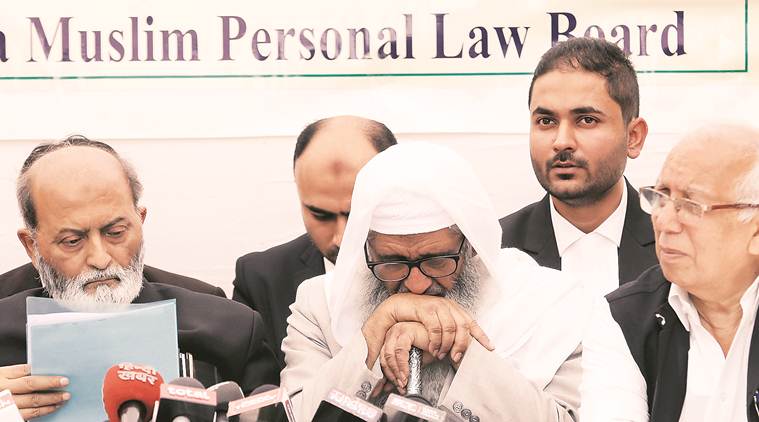 AIMPLB’s Zafaryab Jilani (left) and Kamal Farooqui (right) along with other advocates addressing a press conference in New Delhi after the verdict. (Express photo by Amit Mehra)
AIMPLB’s Zafaryab Jilani (left) and Kamal Farooqui (right) along with other advocates addressing a press conference in New Delhi after the verdict. (Express photo by Amit Mehra)
X factor: There remain concerns that the verdict may not be able to achieve closure. Fears were expressed on Saturday that the judgment may trigger demands at other places, including Mathura and Kashi. The apprehensions are rooted in a wider context of the downgrading of Article 370, and the threats of a Citizenship Amendment Bill discriminatory to Muslims and a countrywide National Register of Citizens. How the Ayodhya judgment plays out remains to be seen.
Read | Citing demolition, court says land for masjid upholds equity, just outcome
Yogi: Yogi Adityanath’s predecessors at the head of the Gorakhnath Mutt, Mahants Avaidyanath and Digvijay Nath, were central figures in the Ram Janmabhoomi movement, and the UP chief minister himself has been a determined votary of the Ram temple. The Supreme Court has directed that the 5 acres of land for the Sunni Central Waqf Board should be allotted either by the Centre out of the land acquired in 1993, or by the state government “at a suitable prominent place in Ayodhya”.
Zafaryab Jilani: The lawyer (along with Rajeev Dhavan) for the mosque side. Jilani has stayed with the matter for almost 30 years now. Rajeev Dhavan appeared pro bono in the Supreme Court, and added an edge to arguments. The order thanks both counsel among others, in the end.
More Explained
EXPRESS OPINION
May 08: Latest News
- 01
- 02
- 03
- 04
- 05




